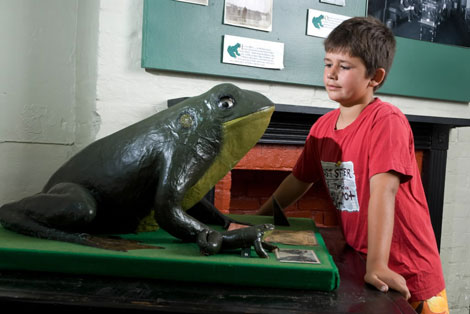
July 31, 2007

Nine-year-old Noah Blanchard looks upon the stuffed Coleman frog. Rob Blanchard/CanWest News Service.
The Coleman Frog was so-called because of its owner, Fred Coleman. The huge specimen is being mentioned again as a tourist attraction to view, if you happen to be visiting Fredericton, New Brunswick, Canada. Tell me, would you want this artifact in your local museum?
At 19 kilograms, the Coleman frog is a monster. Supposedly nurtured to its humongous size on a diet of whey and whisky in the 1800s, the stuffed beast occupies a place of honour in Fredericton’s York-Sunbury Museum, where it is a star attraction.
“People come from all over the world to see it,” said Penny Pacey, the museum’s manager.
Museum staff swear the enormous amphibian is real. Nor is Ms. Pacey alone in her assertions of the grotesque green hopper’s validity.
Tim Andrew, a local “frog expert” and retired deputy minister of agriculture who has studied the origins of the frog for 13 years, recently defended the oft-maligned creature at a public talk at the museum.
Real or not, the Coleman frog — named for its first owner, Fred Coleman — is a true museum piece with a terrific provenance, Ms. Pacey insists. “He is a well-known piece of Fredericton folklore, an artifact dating back well over 100 years and world-famous.”
According to local legend, Coleman first encountered the frog while fishing in Fredericton’s Killarney Lake.
The frog hopped into Coleman’s boat, got a taste for whey and whiskey, and started watching for the owner of the Barker House Hotel whenever he fished thereafter.
The whey diet strengthened the frog’s bones, enabling it to grow to its massive size without collapsing the way other frogs do, Mr. Andrew said.
“You’re familiar with seeing dead frogs? They’re generally flat and the reason is quite simple, as something doubles in size its mass increases by a factor of eight.”
According to Mr. Andrew, the weight of the skin causes the bone structure of most frogs to cave in.
After its death, Coleman sent the frog to Maine to be stuffed. For a number of years, the stuffed animal sat in the hotel’s saloon, where patrons delighted in stubbing their cigars out on the abused amphibian.
One of Coleman’s descendants donated the frog to the museum when it reappeared in a Fredericton attic in the 1950s.
At one point the frog was sent to the Canadian Conservation Institute for work to repair its burn marks.
“There are allegations it’s a phony,” Mr. Andrew said of the frog, which has been featured on Discovery Channel.
David Green, director of the Redpath Museum at Montreal’s McGill University and a curator of vertebrates, laughed when he heard of the Coleman frog. “This is all nonsense, you know.”
Mr. Green said a diet of whisky would kill the frog and contended the only reason frogs are flat is because they get squashed. “If you run over them with cars, it tends to flatten them out quite a bit.”
The world’s largest frogs are goliaths. Found in Central Africa, goliaths are about 30 centimetres in length.
“I don’t suppose we’ll ever put the controversy to rest,” Mr. Andrew said. “It was suggested doing DNA testing on it, but I think we’re reluctant to disturb the peace of a stuffed beast that’s been around quite happily for 123 years now.” by Charles Mandel, CanWest News Service, “Croaks or hoax? Giant N.B. frog stirs controversy,” , July 30, 2007.
DNA sampling? X-Rays? No touching the frog. The mystery continues….
About Loren Coleman
Loren Coleman is one of the world’s leading cryptozoologists, some say “the” leading living cryptozoologist. Certainly, he is acknowledged as the current living American researcher and writer who has most popularized cryptozoology in the late 20th and early 21st centuries.
Starting his fieldwork and investigations in 1960, after traveling and trekking extensively in pursuit of cryptozoological mysteries, Coleman began writing to share his experiences in 1969. An honorary member of Ivan T. Sanderson’s Society for the Investigation of the Unexplained in the 1970s, Coleman has been bestowed with similar honorary memberships of the North Idaho College Cryptozoology Club in 1983, and in subsequent years, that of the British Columbia Scientific Cryptozoology Club, CryptoSafari International, and other international organizations. He was also a Life Member and Benefactor of the International Society of Cryptozoology (now-defunct).
Loren Coleman’s daily blog, as a member of the Cryptomundo Team, served as an ongoing avenue of communication for the ever-growing body of cryptozoo news from 2005 through 2013. He returned as an infrequent contributor beginning Halloween week of 2015.
Coleman is the founder in 2003, and current director of the International Cryptozoology Museum in Portland, Maine.
Filed under Artifacts, Cryptotourism, CryptoZoo News, Cryptozoologists, Cryptozoology, Evidence, Eyewitness Accounts, Folklore, Museums, Swamp Monsters